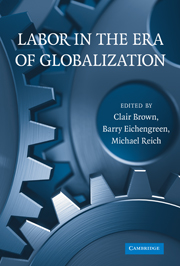Book contents
- Frontmatter
- Contents
- Tables and Figures
- List of Authors and Editors
- Introduction: Labor in the Era of Globalization
- PART ONE POLITICAL ECONOMY AND LABOR MARKET INSTITUTIONS
- PART TWO INSTITUTIONS AND FIRM AND WORKER BEHAVIOR
- 4 How Good Are U.S. Jobs? Characteristics of Job Ladders across Firms in Five Industries
- 5 Increasing Labor Flexibility during the Recession in Japan: The Role of Female Workers in Manufacturing
- 6 Ties That Matter: Cultural Norms and Family Formation in Western Europe
- PART THREE CONTEMPORARY LABOR–MANAGEMENT RELATIONS
- PART FOUR PUBLIC POLICY AND U.S. LABOR-MARKET STRUCTURE
- Index
- References
6 - Ties That Matter: Cultural Norms and Family Formation in Western Europe
Published online by Cambridge University Press: 05 June 2012
- Frontmatter
- Contents
- Tables and Figures
- List of Authors and Editors
- Introduction: Labor in the Era of Globalization
- PART ONE POLITICAL ECONOMY AND LABOR MARKET INSTITUTIONS
- PART TWO INSTITUTIONS AND FIRM AND WORKER BEHAVIOR
- 4 How Good Are U.S. Jobs? Characteristics of Job Ladders across Firms in Five Industries
- 5 Increasing Labor Flexibility during the Recession in Japan: The Role of Female Workers in Manufacturing
- 6 Ties That Matter: Cultural Norms and Family Formation in Western Europe
- PART THREE CONTEMPORARY LABOR–MANAGEMENT RELATIONS
- PART FOUR PUBLIC POLICY AND U.S. LABOR-MARKET STRUCTURE
- Index
- References
Summary
INTRODUCTION
The prevailing family structure in Mediterranean Europe indicates that most young adults live with their parents. In Italy, Portugal, Greece, and Spain, the share of eighteen- to thirty-three-year-olds living at home is between 70 and 80 percent. In the same Mediterranean countries, age at marriage increased and fertility declined in the last thirty years. This peculiar demographic behavior contrasts sharply with non-Mediterranean Europe, the United States, and Canada, where the shares of people living at home range from 10 to 35 percent and fertility did not decline so dramatically during the same period.
The main thesis of this chapter is that this peculiar pattern in Southern European countries could have been caused by differences in cultural norms, as pointed out by historical analysis as well as sociological evidence. According to sociologists, family ties exhibit considerable differences between Northern and Southern European countries. The latter are grouped together as “strong-family-ties countries” and contrast with the “weak-family-ties countries” of Northern Europe and North America (Reher 1998: 206): “The strength or weakness refers to cultural patterns of family loyalties, allegiances, and authority but also to demographic patterns of coresidence with adult children and older family members and to organizing support for the latter.” This chapter presents a cultural interpretation to explain differences in living arrangements, marriage behavior, and fertility in Western Europe. I argue that, indeed, cultural differences in the strength of family ties could help to explain the demographic trends observed in Southern Europe.
- Type
- Chapter
- Information
- Labor in the Era of Globalization , pp. 211 - 238Publisher: Cambridge University PressPrint publication year: 2009



